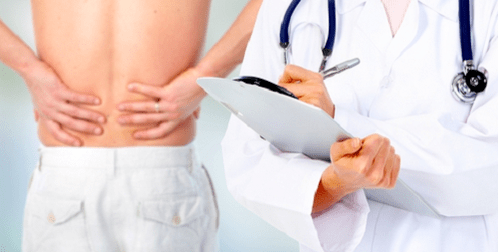Sudden onset, sharp, painful or dull, spreading to the legs, pain in the lower back, the cause of which can not always be determined immediately, may indicate the development of various diseases. Only an experienced doctor will be able to understand exactly what causes pain syndrome by studying the clinical picture, the patient's complaints, as well as the results of ultrasound, X-ray or MRI examinations and tests. But often, even before going to the doctor, the person wants to know in advance what the condition is related to.

The main causes of back pain
First of all, all the causes of back pain can be divided into two main types:
- Primary (pain is precisely associated with pathology of the spine, intervertebral discs, muscle tissue, or joints).
- Secondary (pain occurs with pathologies of the internal organs and is transmitted to the lower back, as well as due to infectious diseases in the body, the development of tumors).
The main causes of back pain
Today, bipedalism is called the cause of all diseases of the spine. The load on the spine increases strongly with an upright position of the body, especially in the lower part - it wears out faster.
The main causes of back pain are:
- Osteochondrosis of the lumbar spine. Degenerative changes in the spine cause severe pain, inflammation, swelling in the affected area, difficulty moving. Characteristic changes in the cartilage tissue of the spinal discs and vertebral bodies often lead to nerve compression, which is manifested by sharp pain.
- Spondyloarthritis. This pathology affects the articular tissue in the region of the spine. In addition to pain in the joints, a person with spondyloarthritis may experience severe stiffness of movements when it is not possible to straighten or turn.
Low back pain caused by osteochondrosis or spondyloarthritis requires urgent, emergency medical care and, of course, emergency treatment.
Secondary back pain
Many diseases that are not associated with pathological processes in the spine can cause unpleasant back pain.
There are secondary causes of low back pain, for example:
- curvature of the spine (scoliosis, lordosis, etc. );
- infections of various origins affecting the intervertebral discs (tuberculosis, etc. );
- urinary tract infections and flu consequences;
- inflammatory processes in the genitals;
- gastrointestinal diseases (appendicitis, pancreatitis, cholecystitis, intestinal colic);
- kidney disease;
- oncological diseases localized in the peri-lumbar region;
- excess weight;
- osteoporosis, acute rheumatism, chronic arthritis;
- stand or sit for a long time;
- muscle spasm;
- nervous tension, stress.
Diseases of the internal organs have their own bright symptoms, reflected only in the lower back.
Causes back pain in women and men
The structure of the female body is prone to the appearance of heaviness and pain in the lower back. This is due to the hormonal background: the menstrual cycle, menopause and pregnancy affect the lumbar region, because the reproductive organs are located nearby. Gynecological diseases (inflammation of the appendages and uterus) cause radiation back pain in women.
Similarly, in men, prostatitis and inflammation of the epididymis cause pain. It happens that in men, from time to time in a cold, there is back pain during constant work in the cold, or the work is associated with lifting weights. Such causes of low back pain require preventive measures: you need to warm your back and wear a special corset.
Muscle clamps
Separately, I would like to focus on one point, such as muscle spasms, which are often the cause of back pain. Lack of regular physical activity causes the back muscles to become weak and unable to withstand long or increasing loads. Therefore, working on the legs or in a sedentary sitting position causes overload and pain in the back muscles.
Stress has the same effect when muscle tension develops as a result of emotions of fear or anger. If it is not eliminated in time, it is accompanied by spasm and pain.
Mutual symptoms
Low back pain caused by spinal cord injuries is most often accompanied by the following symptoms:
- discomfort can not only cover the back, but can also spread to the hips and lower limbs;
- movement can be very difficult or completely impossible;
- The affected area is usually inflamed and swollen.
For any of these symptoms, seek medical attention from a neurologist. If there are other accompanying symptoms, then it is better to contact a therapist who will determine the causes of low back pain and then refer you to a specialist or prescribe treatment.












































